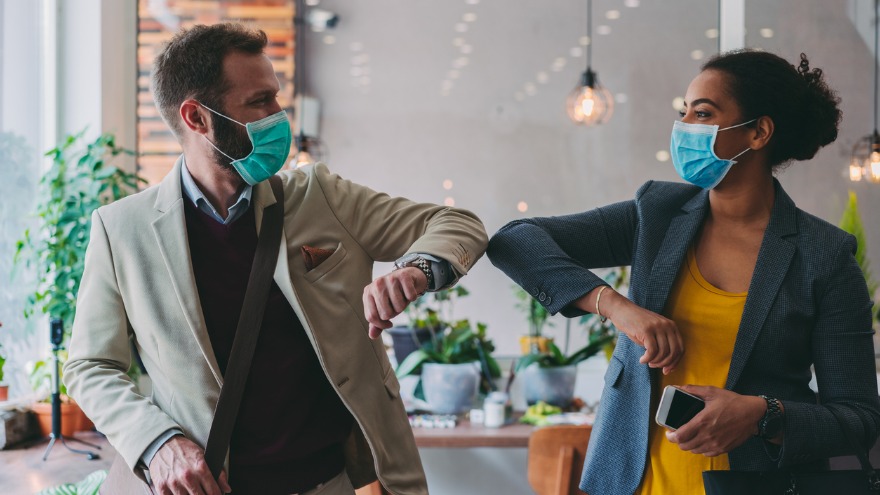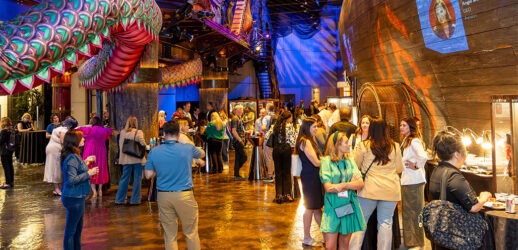Tips for calming yourself, your team and your attendees’ meeting jitters
“We are social animals. Not only do social activities benefit our moods, but they help our thinking and memory as well.” –Dr. Andrew E. Budson
After more than a year of being told that being around other people could literally kill you, feeling comfortable in a ballroom of strangers will not be as easy as flipping a switch after a jab or two in the arm. After all the months of talking through a computer screen in sweatpants, walking up to someone and making small talk could feel strange even if everyone is vaccinated and has tested negative for Covid-19. Masks and distancing and all the other new protocols may make the exchange safer but not necessarily any easier.
Yes, you have to make sure everyone is physically protected, but now it falls to meeting professionals to throw them a lifeline, as well, so they feel emotionally safe. Smart Meetings asked the experts for strategies to sooth attendees’ souls as they dip their toes back into real life once again.
Rx for a Mental Health Crisis

According to a recent white paper by Ezra, the professional coaching app, months of working from home has resulted in psychological effects a lot of people simply weren’t prepared for. Loneliness, isolation and stress have led to anxiety, lethargy, even depression. Symptoms can include bursts of anger, anxiety, agitation, increased cravings for food or even physical problems like headaches and back pain.
More: Q&A with Rachel Sheerin on Banishing Burnout and Reinventing Joy
Even those never infected with the disease can suffer from what Dr. Andrew E. Budson deemed “brain fog” in a recent Harvard Medical School article. The uncertainty and deluge of bad news over the roller-coaster of a year, paired with a lack of human stimulation or change of scenery, has left many feeling off balance. This “fuzzy brain” is often characterized by sluggish thinking, forgetfulness or other cognitive challenges.
Budson Compared It to Feeling Jet-lagged
Understanding where your attendees are coming from—mentally—can help you understand what resources you need to put in place for when they arrive on site. Luckily, one of the cures for Covid brain, according to Budson, is socializing. “We are social animals. Not only do social activities benefit our moods, but they help our thinking and memory, as well.”
Empathetic Design
“Once you attend one event, you will be more comfortable attending the second and third time.”–Victoria Matey

Victoria Matey, author of Strategic Planning: 10 Principles for Creating Meaningful and Impactful Business Events, says the disoriented sensation people are feeling is a direct outgrowth of how our brains are wired to react to stress.
“They feel they aren’t in control. On a brain level this brings a lot of anxiety and uncertainty and consumes a lot of energy,” said the instructor of a new Event Psychology Lab for Smart Event Planners. “Brains hate the current situation because they can’t predict what is going to happen,” she explained.
We can all relate: Constantly being on alert for danger is emotionally and physically draining.
Fundamentally, trust is missing. “People don’t trust that others will act responsibly,” Matey said. They know they can take precautions—wash hands and wear a mask correctly and consistently—but will others? It will take time for people to return to a resting state, she cautioned, adding, “We aren’t robots; we don’t have switches.”
What will usher in a more confident mindset? “Small things, reminders, statements about safety measures matter. They affect people on a brain level and make them feel that they are more safe, more in control,” Matey said.
Sanitation “theater” matters, because visibly cleaning surfaces reassures more convincingly than telling people about protocols. Another powerful calming influence? Personal experience. “Once you attend one event, you will be more comfortable attending the second and third time. It is about social proof,” she said.
Until everyone reaches nirvana, empathy matters. “Think through what your attendees’ lives are like beyond the event environment. Structure the event design to meet their needs,” she said.
End-to-End Support
“People need to feel safe getting to the venue, in the destination and on site.”–Eric Holmen
Helping people feel comfortable is not a single item to check off a list. Eric Holmen, chief revenue officer with Splash event marketing platform, stressed the importance of messaging to ease pandemic anxiety before, during and after the event.
The focus on mental safety starts when picking the venue. “People need to feel safe getting to the venue, in the destination and on site,” he said. Choose venues that have earned their safety designations, such as GBAC STAR, have a history of executing safe gatherings and offer alternatives like outdoor space.
In your event marketing, tell people what you mean when you say the meeting will be “compliant.” Let them click through to the details, such as whether there will be temperature checks, mask requirements, etc.
Airlines have led the way, he noted, by changing their home page imageries from a picture of a happy vacationer kicking back in Puerto Vallarta to an employee spraying down a tray table. Including information about a virtual option could be a smart move, a security blanket for people going to the in-person venue during a hybrid event. If someone decides at the last minute not to fly to the event or gets there and feels uncomfortable, knowing there is a back-up virtual plan, especially if it is being broadcast a couple of days later or on demand, lets them know they aren’t being forced to attend.
Broadcasting safety measures on social media in a fun way can reassure potential attendees and get people excited before the event. “Tweeting that the thermal scanners arrived is a way to remind people security is happening in a fun, lively way,” Holmen said.
It’s been so long since some people have traveled they may be anxious about doing everything right. They may not quite remember how to get through TSA, what’s allowed and what isn’t, and what line to stand in next. Be transparent and open about what will happen and what will be required on site. Is it proof of a recent negative Covid test, a vaccine card, a form filled out? Tell them early and often, so they aren’t surprised or flustered about what to do.
On site, kind but pervasive reminders—mask-requirement stickers on the restroom mirrors, markers on the floor telling them where to stand—go a long way. Holmen endorsed using humor, up to a point. You still need people to take six-foot distancing messaging seriously.
📍 Smart Tip: Give people an easy way to text or email the organizer if they see something not in compliance—so they feel heard, and you can address the issue quickly. “You don’t want attendees to have to make the decision about whether to confront someone,” he said.
Post-event, ask people how they felt. You might want to include a whole section about safety in your surveys. (At the same time, ask for quotes about their perceptions you can use in future marketing.) This is also the time to turn photos of signage and thermal scans into an asset library you can post online to help the next event be even more successful.
Build Networking Muscle Carefully

Even though numerous studies, including a survey by APCO Insight, find that a supermajority of people miss meeting face to face (78 percent said they are eager to return to business events once restrictions are lifted and the virus threat is contained), the experience of standing at a welcome reception facing a sea of masked faces could still be jarring.
Debra Fine, author of The Fine Art of Small Talk, warned that it will be easy to be distracted the first few times because there are so many new things to take in. She suggested taking a deep breath when you walk into the room, focusing on just being present.
But what about that mask over your mouth? Exaggerate body language, hand movements, facial expressions (at least the top half of the face) and vary your tone of voice, she advised. This will help to convey meaning when the mouth is covered. “Show the enthusiasm you feel about getting back in public.”
More: The Art of Nonverbal Communication (Or, If You Think You’ve Got This Zoom Thing Down, Think Again!)
The first challenge could come before a word is said. Many will be unsure how to greet each other in a socially acceptable way. Fine favored making the first move by initiating an elbow bump or a namaste, followed by a laugh; then be prepared to mirror whatever you are comfortable with. Whatever you do, don’t take a hard pass on acknowledging your fellow attendee.
“Not having a greeting would just be bizarre,” she said.
If your small-talk joints are a little rusty, Fine also had tips for starting the conversation. She suggested asking questions carefully—some topics normally used as openers could be fraught. It can be dangerous to ask about work at a time when a lot of people were laid off, for example. She suggested an opening line along the lines of: “These have been crazy times, catch me up.” Or, for the more daring: “What were the silver linings, if any, over the last year?”
In awkward situations, a shared chuckle is networking gold. “Making people laugh is the most important thing you can do right now,” she said.
The biggest taboo for those returning to banquet rooms? “Don’t look at your phone,” she said unequivocally. If you took the time to travel to a venue to finally be around other people again, why focus on things outside the event?
To make the attendee’s job easier, Fine also had icebreaker suggestions for meeting organizers. Primarily, she suggested introducing discussion topics, so people don’t have to come up with their own. She described an event she was at recently: The host acknowledged the “elephant in the room” (the virus and vaccines) and invited people to discuss these for 15 minutes before she put the topic off limits for the rest of the day.
She also proposed accommodating attendees who might not be geared up for the long days they previously spent interacting with others. “Attention spans are different,” she said. Consider creating agendas with shorter keynotes, fewer days and rest periods where everyone can have some quiet time alone.
Common Experiences

Did this happen to you the first time you were back in a breakout room? You knew exactly what you wanted to say, but just couldn’t find the word you were looking for? Blame it on Covid brain. Jonathan Bradshaw, who trains some of the world’s largest corporations on Meetology using the behavioral science powering human interaction, says the struggle is real. “Being social is like a muscle. You get stronger the more you use it,” he explained.
But just like coming back from a muscle injury, you want to walk before you run, or you might reinjure yourself. That’s why he suggested starting out slowly, with smaller groups.
Bradshaw recommended focusing on what people have in common, which is one of the easiest ways to form a connection. Everyone has lived through a challenging year. Give people permission to talk about their best and worst Zoom experiences and what they missed most about meeting face to face.
“Address what everyone is thinking about,” he advised.





